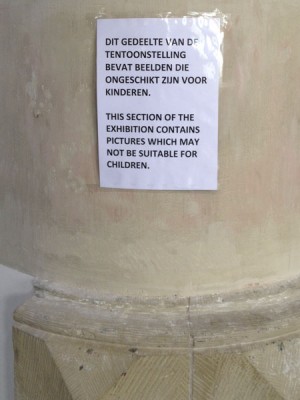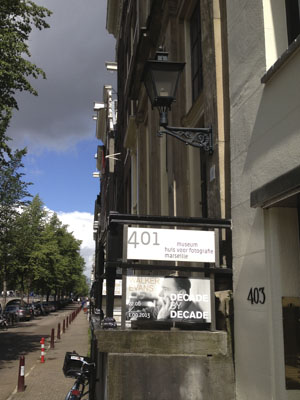The weather was a bit changeable at the beginning of this week, so a perfect opportunity to catch up on my exhibition visits. I visited two as a matter of fact: World Press Photo in Naarden and Decade By Decade about Walker Evans at Huis Marseille in Amsterdam.
A visit to World Press Photo is an annually returning event. You can read my posts on the visits of the previous years. This year was slightly different, though. First of all, 2012 was the year of the Olympics which resulted in a larger than usual number of photos in Sports. Secondly, this year I noticed the large number of photos in the Nature category. I’m not sure if this number was actually higher than in previous years, but it felt that way anyhow.
 Finally, another change to previous years, pictures with shocking and confronting content were exhibited in a separate section of the exhibition. There was an explicit warning that the section might not be suited for children. In previous years this type of pictures was more or less mixed with the other photos being presented. It left many people, including myself, with a slight nausea afterwards. This new approach is much better, for now everyone can decide for himself to enter the section or not and watch the, in many cases, pictures with their horrible content. An improvement in setup, as far as I’m concerned.
Finally, another change to previous years, pictures with shocking and confronting content were exhibited in a separate section of the exhibition. There was an explicit warning that the section might not be suited for children. In previous years this type of pictures was more or less mixed with the other photos being presented. It left many people, including myself, with a slight nausea afterwards. This new approach is much better, for now everyone can decide for himself to enter the section or not and watch the, in many cases, pictures with their horrible content. An improvement in setup, as far as I’m concerned.
Besides the appalling and repulsive pictures of war, crime and violence that continues in many parts of our world (Syria was well represented in this area this year), fortunately there were many pictures to compensate this. As mentioned before, pictures in Sports and Nature, but also in, closer to my heart, Portraits (Staged and Observed). In this latter category I found the 1st prize by Nemanja Pancic most impressive. The way it was exhibited (huge print) and the story behind it, made this for me an exceptional shot.
In contrast with the photo journalism of the world’s reality of today, was the exhibition about the work of Walker Evans. Is it in contrast? I assume that people with an above average interest in photography have come across Walker Evans’ name. There’s plenty of information about his life and work to be found on the internet, but let me add my modest two cents here.
Walker Evans is by many seen as one of the leading figures of 20th-century photographic history. His style is also regarded as having laid the foundation for documentary photography. So look at his work as series of pictures about a certain theme or subject.He is probably most known for his documentation of day-to-day life in a changing America.
 The exhibition contains over 200 original photographs providing a retrospective of his entire oeuvre. As mentioned before, documentary photography should be interpreted as series of pictures with a certain cohesian. The exhibition is therefore setup around periods (the “Decades”) in Evans’ life covering a certain theme or subject. So you can see Early Work: New York, Victorian Architecture, Gladiolas, Cuba, et cetera. But he’s widely known for documenting the Great Depression. There’s a separate section called The Depression Years: The South. Evans undertook several trips to the southern states in the ’30s where he documented the architecture of the former mansions (Victorian Architecture). But he also took pictures of simple and poor buildings. Above all, however, he was interested in the people. Using an angle viewfinder, he took a kind of candid, true-to-life portraits. He also used a similar approach in the series called The Subway Portraits (in New York) where people were not aware of being photographed. Although he was contracted by the Farm Security Administration (FSA) to document social and economic living conditions in photographs, he clearly pointed out that his photographs were pure recordings and no political propaganda. So he recorded the simple homes of craftsmen and miners. “My eye is interested in streets that have just rows of wooden houses in them. I find them and do them. I collect them.”
The exhibition contains over 200 original photographs providing a retrospective of his entire oeuvre. As mentioned before, documentary photography should be interpreted as series of pictures with a certain cohesian. The exhibition is therefore setup around periods (the “Decades”) in Evans’ life covering a certain theme or subject. So you can see Early Work: New York, Victorian Architecture, Gladiolas, Cuba, et cetera. But he’s widely known for documenting the Great Depression. There’s a separate section called The Depression Years: The South. Evans undertook several trips to the southern states in the ’30s where he documented the architecture of the former mansions (Victorian Architecture). But he also took pictures of simple and poor buildings. Above all, however, he was interested in the people. Using an angle viewfinder, he took a kind of candid, true-to-life portraits. He also used a similar approach in the series called The Subway Portraits (in New York) where people were not aware of being photographed. Although he was contracted by the Farm Security Administration (FSA) to document social and economic living conditions in photographs, he clearly pointed out that his photographs were pure recordings and no political propaganda. So he recorded the simple homes of craftsmen and miners. “My eye is interested in streets that have just rows of wooden houses in them. I find them and do them. I collect them.”
There was a section dedicated to portraits: The Subway Portraits. A series he made in New York after he completed his work for the FSA. He simply sat opposite the passengers and hid his camera in his coat. Just the lens was popping out and a simple cable release (hidden in his sleeve) enable him to take candid shots. As to why he made these portraits during the subway rides and difficult lighting conditions, he once said: “A rebellion against studio portraiture. I was angry. It was partly angry protest – not social, but aesthetic – against posed portraiture.” I was a bit disppointed, though, that some of his most well-known portraits, eg. Wife of a cotton sharecropper (Allie Mae Burroughs, 1936) was not exhibited. The same applies to Penny Picture Display (Savannah, GA, 1936).
Still, both exhibitions are definitely worth visiting. If you’re in a position to do so, I’d most certainly recommend both. They cover a different time and age, obviously, but the pictures in both exhibitions are just recordings of what’s happening in our day-to-day lives. Whether this is applied to our current time and across the world, or to the first half of the 20th century in America, doesn’t really matter. Not such a contrast, after all.

